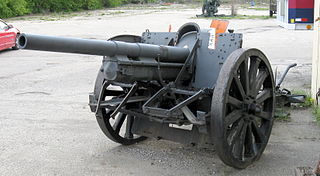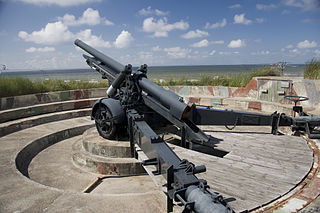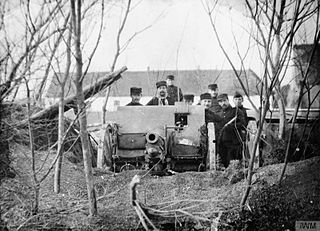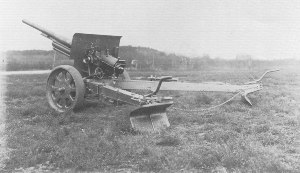
The Cannone da 75/27 modello 11 was a French-designed field gun produced in Italy prior to World War I. It was introduced in 1912, designed by Joseph-Albert Deport. It was taken into service by Italy for use with its Alpine and cavalry troops going into World War I, and was built there in large numbers. The gun was designed with two notable features. It was the first artillery piece to introduce the split trail, as well as the last to utilize its novel dual-recoil system. The former became a very popular feature on artillery pieces through to the modern day. The later, while functional, did not get repeated. The dual-recoil system consisted of a small tubular recoil under the barrel which in turn traveled in a traditional rectangular cradle. This lessened heat transfer from the gun barrel to the recoil mechanism effectively, but was not necessary for the added complexity.

The 7.7 cm Feldkanone 16 was a field gun used by Germany in World War I. Most surviving examples in German service were rebarreled after the war as the 7.5 cm FK 16 nA. A total of 298 guns of the old type were still in German army service in 1939, making it the oldest field artillery piece in German inventory at the beginning of the Second World War.

The 7 veld was a later Dutch designation of the Krupp 7.5 cm Model 1903 field gun.

The 8 cm kanon vz. 30 was a Czech field gun used in World War II. Guns captured after the German invasion of Czechoslovakia in March 1939 were taken into Wehrmacht service as the 8 cm FK 30(t). It was used by a variety of German units during World War II, including I./SS-Artillerie-Abteilung 3 between 1939 and 1940.

The 10 cm houfnice vz. 30 was a Czechoslovak howitzer used in the Second World War. The 158 weapons captured after the German invasion of Czechoslovakia in March 1939 were taken into Wehrmacht service as the 10 cm leFH 30(t). It was used by a variety of German units during World War II, including II. and III./SS-Artillerie-Abteilung 3 between 1939 and 1940 and SS-Artillerie-Abteilung 51 during 1941. 30 served with the Slovak Army.

The 8 cm Feldkanone M.5 was a field gun used by Austria-Hungary during World War I. It was a conventional design, with its most notable feature being its obsolescent autofrettaged bronze barrel, necessary because Austria-Hungary still had trouble making steel of the proper quality.

The 15 cm Autokanone M. 15/16 was a heavy field gun used by Austria-Hungary in World War I. Guns turned over to Italy as reparations after World War I were taken into Italian service as the Cannone da 152/37. Austrian and Czech guns were taken into Wehrmacht service after the Anschluss and the occupation of Czechoslovakia as the 15.2 cm K 15/16(t). Italian guns captured after the surrender of Italy in 1943 were known by the Wehrmacht as the 15.2 cm K 410(i). Due to their unique ammunition, the Germans did not use them that much, and generally served on coast-defense duties during World War II.

The Canon de 12 cm L mle 1931 was a medium field gun made and used by Belgium in World War II. Captured guns were taken into Wehrmacht service after the surrender of Belgium in May 1940 as the 12 cm K 370(b) where it was generally used on coast defense duties.

The 15 cm schwere Feldhaubitze M 14 was a heavy howitzer which served with Austria-Hungary during World War I.

The Canon de 75 modèle 1905 à tir rapide was a field gun used by Belgium during World War I and World War II.
The Canon de 75 mle GP I was a field gun used by Belgium during World War II. Cockerill mounted lengthened Canon de 75 mle TR barrels on ex-German 10.5 cm leFH 16 howitzer carriages received as reparations after World War I. After 1940, the Wehrmacht designated captured guns as the 7.5 cm FK 233(b) and used them to equip occupation units in Belgium.
The Canon de 75 mle GP II was a field gun used by Belgium during World War II. Cockerill mounted lengthened Canon de 75 mle TR barrels on ex-German 7.7 cm FK 16 gun carriages received as reparations after World War I. After 1940, the Wehrmacht designated captured guns as the 7.5 cm FK 234(b) and used them to equip occupation units in Belgium.

The Krupp 7.5 cm Model 1903 was a field gun used by a number of European armies in both World War I and World War II.

The Cannone da 75/27 modello 06 was a field gun used by Italy during World War I and World War II. It was a license-built copy of the Krupp Kanone M 1906 gun. It had seats for two crewmen attached to the gunshield as was common practice for the period. Captured weapons were designated by the Wehrmacht during World War II as the 7.5 cm Feldkanone 237(i).

The Obice da 105/14 modello 18 was a howitzer used by Italy during World War II. The howitzer was designed by Schneider in 1906. It was chosen by the Italian Regio Esercito to serve as their new field gun, but licence production by Ansaldo was slow. Some more were produced during the interwar years, but the captured Austrian Obice da 100/17 was generally considered to be superior.

The 10.5 cm cannon Model 1927 was a heavy field gun used by the Netherlands and Hungary during World War II. Dutch guns were known as 10-velds. Hungary purchased a license and built them as 31 Ms. Captured weapons were designated by the Wehrmacht as the schwere 10.5 cm Kanone 335(h). Four were bought by the Swedish Coastal Artillery as 10.5 cm kanon m/27s. They were later upgraded to m/34 standard as m/27-34s. They were transferred to the field artillery in 1942. The Dutch appear to have bought guns with both 40 and 42 caliber barrel lengths.

The Armata 75 mm wz.02/06 was a light field gun used by Poland before and during World War II. It began life as the 76 mm divisional gun M1902, a Russian light field gun used in the Russo-Japanese War, World War I, Russian Civil War and Polish–Soviet War.
The 8 cm kanon vz. 28 was a Czech field gun used during World War II.
The 10 cm houfnice vz. 28 was a Czech howitzer used in limited numbers by the Yugoslav Army during World War II. The Yugoslavians ordered twenty houfnice vz. 28 guns which they referred to as the 100 mm M.28. Guns captured from Yugoslavia by the Germans were given the designation 10 cm leFH 317(j).
During World War II, Germany maintained comprehensive lists of enemy weapons which were given designations in German in a system that matched that of German weapons. When these weapons were captured and put into use with German forces they were referred to by these designations.















